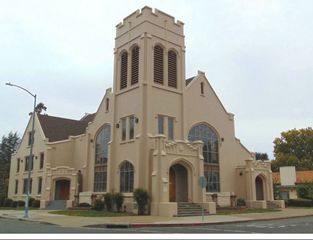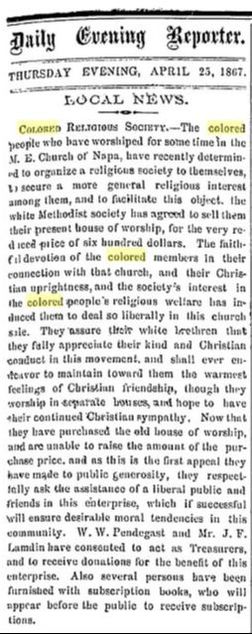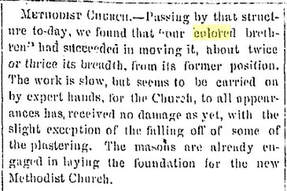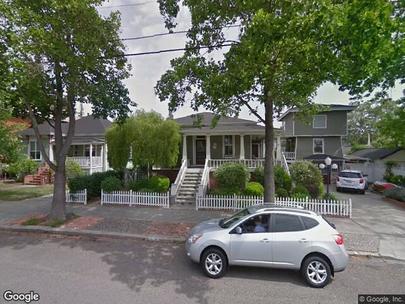This article was published in the Martinez News-Gazette on 02/25/2018 and is the ninth part of our continuing story about Aaron Rice and his family.When last we wrote about Aaron and his family, they were experiencing the turbulent Civil War period of California and the heartbreak they endured from the loss of their youngest son. However, we need to back track slightly too now discuss an even more impactful aspect of their daily lives. During the 1860s, newly freed African Americans built communities through churches. Within those walls they found their social, spiritual, educational and political needs fulfilled.  First United Methodist Church Napa, Corner of Randolph & Division built 1917 First United Methodist Church Napa, Corner of Randolph & Division built 1917 For Aaron’s family, it was the integrated Methodist Episcopal Church (North), at the corner of Randolph and Division Streets in Napa, (where it is still located today). For obvious reasons they would have preferred their own church, but the closest was the African Methodist Episcopal Church (AME) in Sacramento. By horse and carriage, it would have been a day’s trip in either direction. The Methodist Episcopal Church had two distinct congregations, the North’s comprised of abolitionists who believed in equality and the South’s, aka “Southern Methodist Church”, composed of pro-slavery Southern migrants.  April 11, 1863 Courtesy Public Domain April 11, 1863 Courtesy Public Domain Despite being members of an integrated church, they still needed outlets for discussing their specific communities’ issues. For political and social news, Aaron’s family would have turned to their neighbors the Hatton’s. Edward Hatton was a Napa barber and agent for both the Pacific Appeal and The Elevator newspapers from San Francisco. (If you recall from our earlier columns, Edward Hatton volunteered to be Aaron’s bail when Aaron was convicted of perjury.) The Pacific Appeal was an African American newspaper founded in 1862 by Phillip Alexander Bell and Peter Anderson. (Louis’s obituary notice appeared in its May 1862 issue.) The Elevator was another African American newspaper founded in 1865. Both newspapers were a vital component of their budding societies.  May 12, 1865 Courtesy Public Domain May 12, 1865 Courtesy Public Domain Although Napa’s M.E. congregation was anti-slavery, cultural differences made it difficult for Whites and African-Americans to have agreement when it came to politics and education. With the only AME Church being so far away, African American Napans decided to found their own church. On the evening of April 25, 1867, the Daily Evening Reporter announced, “The colored people who have worshipped for some time in the M. E. church of Napa, have recently determined to organize a religious society to themselves to secure a more general religious interest among them, and to facilitate this object. The white Methodist society has agreed to sell them their present house of worship, for the very reduced price of six hundred dollars.  April 25, 1867 Courtesy Public Domain April 25, 1867 Courtesy Public Domain The faithful devotion of the colored members in their connection with that church, and their Christian uprightness, and the society’s interest in the colored people’s religious welfare has induced them to deal so liberally in this church sale. They assure their white brethren that they fully appreciate their kind and Christian conduct in this movement, and shall ever endeavor to maintain toward them the warmest feelings of Christian friendship, though they worship in separate houses, and hope to have their continued Christian sympathy. Now that they have purchased the old house of worship, and are unable to raise the amount of the purchase price, and as this is the first appeal they have made to public generosity, they respectfully ask for the assistance of a liberal public and friends in this enterprise, which if successful will ensured desirable moral tendencies in this community. W. W. Pendegast and Mr. J. F. Lamdin have consented to act as Treasurers, and to receive donations for the benefit of this enterprise. Also several persons have been furnished with subscription books, who will appear before the public to receive subscriptions.” In 1867, William W. Pendegast was a Napa attorney who later became a California Democratic State Senator, while J. F. Lamdin was an express agent for both Wells Fargo & Co., and Aetna Home and Fire Insurance.  Daily Evening Reporter - May 4, 1867 Courtesy Public Domain Daily Evening Reporter - May 4, 1867 Courtesy Public Domain On May 4, 1867, the Daily Evening Reporter stated, “Passing by that structure to-day, we found that “our colored brethren” had succeeded in moving it, about twice or thrice its breadth, from its former position. The work is slow, but seems to be carried on by expert hands, for the church, to all appearances has received no damage as of yet, with the slight exception of the falling off of some of the plastering. The masons are already engaging in laying the foundation of the new Methodist Church. From a October 2, 1867 Napa property deed we found that a Jonathan E. Pond and his wife Amanda E. Pond sold to, “E. Hatton, A. G. Jones, J. E. Nichols, Nathaniel Rice, Aaron Rice, Wm Brooks, and G. W. Beatty, Trustees of the Colored Methodist Episcopal Church” for $250 the, “Northern half of Lot number four (4) in Block number nineteen (19) in the Town of Napa,” which would now be the middle of Oak between Randolph and Franklin streets. Now we know that at least by the date of this deed, Nathanial was finally free and reunited with his family.  2014 Approximate Location of AME Church 1326 Oak St, Napa Courtesy Google Inc. 2014 Approximate Location of AME Church 1326 Oak St, Napa Courtesy Google Inc. With the property sale completed, the African American community of Napa had officially begun their church. However with only 30 parishioners, finding a permanent minister was difficult. Aaron’s father Rev. Robert Rice would often officiate, despite not having any formal training. Also during the 1860’s, most schools were located within a church structure as public schools were not founded until the late 1870’s. The A.M.E. Church was no different. While the church was thriving, Robert sells two thirds of the farm (that he and Charlotte purchased in 1860) to Aaron in 1869 for one dollar. Presumably Nathaniel was to receive his third after he married, although to date we haven’t found anything to corroborate this having occurred. The year that follows has an even bigger political impact on the African American community, and their church, in Napa, CA. The authors of this column would very much like to thank Archivist Alexandria Brown for her help with our research and providing the articles quoted in this column regarding the AME Church of Napa. None of our work to date could have been achieved without the generous support and collaboration of other professional researchers. To all of them we offer a huge debt of gratitude and thanks. Judie & Joseph Palmer are two of the founding members of the Martinez Cemetery Preservation Alliance (MCPA) and the Potter’s Field Project. Both have a passion for discovery, history, genealogy, anthropology and archaeology. For more info, please visit our website MartinezCemetery.org. Do you have a Potter’s Field story to tell? We welcome any pictures or information regarding the Alhambra Pioneer Cemetery or its Potter’s Field. Please email us at [email protected] or call us at (925) 316-6069. |
AuthorsJudie & Joseph Palmer are two of the founding members of the Martinez Cemetery Preservation Alliance (MCPA) and the Potter’s Field Project. Both have a passion for discovery, history, genealogy, anthropology and archaeology. Archives
October 2021
Categories |

 RSS Feed
RSS Feed